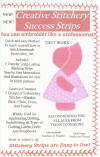the oval-shaped beads used for the tail.
Head: 1 - round 6mm clear glass bead
Body: 1 - round 6mm Cloisonne' bead
Wings: 4 - 13mm dagger beads
Tail: 6 - 5mm oval beads
Beading thread that will blend into background
Beading needle, (or fine #11 or #12 short quilting needle)
Directions and illustration shown below.

The dragonfly is designed to be sewn directly in place onto fabric.
The dragonfly's body is attached first, using the Cloisonne bead, and positioning the bead opening to run horizontally. Attach the body firmly to the fabric using two or three passes through the hole and the fabric. Pass the needle and thread through the body and then thread the needle through the holes in the narrow tip of two of the dagger beads, and then pass the needle back through the Cloisonne bead, exiting on the other side of the body. Thread through the two remaining wings, and then back through the body. Do this a couple of times, being sure that the body and wings are strung together tightly enough to keep them in place, but not so tight that you bread the bead. Refer to the photo and the illustration. If they seem to be a little wobbly, take a couple of stitches up through the fabric where the set of wings attach to the body and down over the thread that holds the two wings together. Repeat for the second set of wings. Do this until each side feels tightly attached.
Attach the clear glass bead for the head. The holes in the bead should run horizontally, and should be sewn in place just as you did the body. Be sure to snug the head tightly against the body while you sew it in place. Pick up one of the tiny glass beads for the eyes, and then run the thread back through the head, and then repeat for the second eye. Take the thread down to the fabric by running the needle down through the space in between one of the eye beads and the head. This helps to hide the thread a little better.
The tail is attached by bringing the thread up snugly against the body, and then through one of the oval beads. Go back down through the fabric and back up at the beginning of the first bead, and then run the thread back through the first bead again. Thread on the second bead, then go back down through the fabric, back to the beginning of the second bead and back through the second bead, and then on through the third bead. Repeat until all six beads are in place.
Hope you enjoy making them!!!

 Illustration #1
Illustration #1  Illustration #2
Illustration #2 Illustration #3
Illustration #3 Illustration #4
Illustration #4 Illustration #5
Illustration #5  Illustration #6
Illustration #6 Illustration #7
Illustration #7 
 Illustration #9
Illustration #9  Illustration #10
Illustration #10
























%2B(650x228).jpg)










